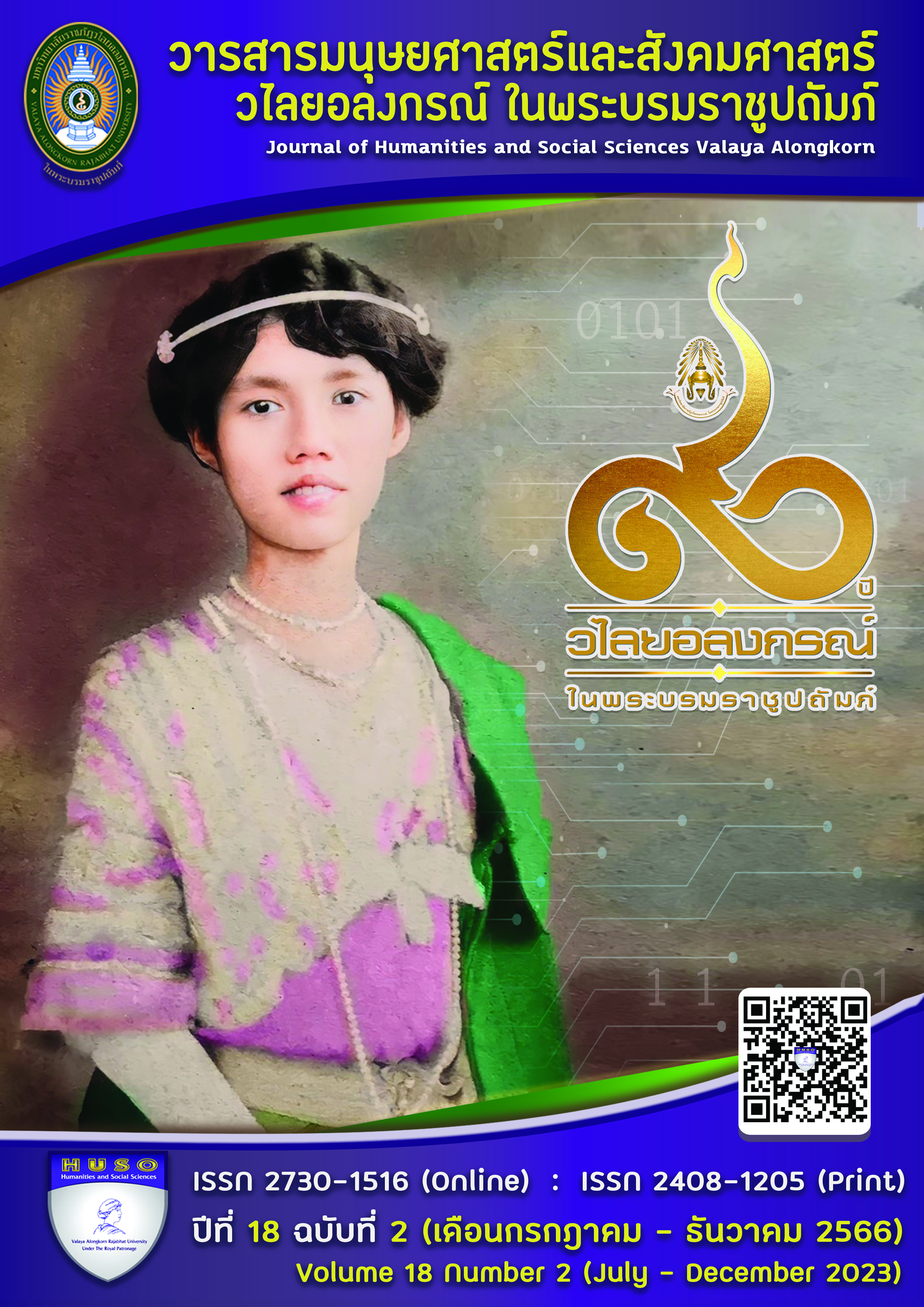The THE HISTORY AND CHARACTERISTICS OF THAI POPULAR SINGING DURING 1925 - 1967
Main Article Content
Abstract
Thai popular singing is a musical activity that is very popular in Thailand. Especially the singing that comes from the songs of Suntraporn band and luk-krung style. These songsare continually being re-recorded for sale. Until today, these songs are used as main elements in television singing competitions. This article therefore presents synthetic data on three main principles, namely (1)the history of singing in Thailand before 1967 to create an understanding of the source and development of singing in Thailand, which has led to the singing of Thai popular songs; (2) the history of Thai popular singing during 1925 – 1967, which presents the timeline of the phenomenon of singing through the entertainment business and government administration policies that led to the popularity of Western-style Thai music among Thai people at that time; and (3) the characteristics of Thai popular singing during 1925 – 1967, which presents five characteristics, including the natural voice projection, the vibrato, the neumatic singing, the melismatic singing, and the interpretation and emotional expression. These data show the connection between Thai traditional singing and the influence of Western music entering Thailand that leads to Thai popular singing having characteristics, which is unique and different from the popular singing of the West and other nations. Because the characteristics of Thai popular singing during 1925 – 1967 came from the combination of singing skills in Western popular music and Thai culture and ways, such as language, expression, beliefs, ideas, etc.
Article Details

This work is licensed under a Creative Commons Attribution-NonCommercial-NoDerivatives 4.0 International License.
ลิขสิทธิ์บทความวิจัยที่ได้รับการตีพิมพ์เผยแพร่ในวารสารมนุษยศาสตร์และสังคมศาสตร์ วไลยอลงกรณ์ ในพระบรมราชูปถัมภ์ ถือเป็นกรรมสิทธิ์ของคณะมนุษยศาสตร์และสังคมศาสตร์ มหาวิทยาลัยราชภัฏวไลยอลงกรณ์ ในพระบรมราชูปถัมภ์ ห้ามนำข้อความทั้งหมดหรือบางส่วนไปพิมพ์ซ้ำ เว้นแต่จะได้รับอนุญาตจากมหาวิทยาลัยเป็นลายลักษณ์อักษร
ความรับผิดชอบ เนื้อหาต้นฉบับที่ปรากฏในวารสารมนุษยศาสตร์และสังคมศาสตร์ วไลยอลงกรณ์ ในพระบรมราชูปถัมภ์ เป็นความรับผิดชอบของผู้นิพนธ์บทความหรือผู้เขียนเอง ทั้งนี้ไม่รวมความผิดพลาดอันเกิดจากเทคนิคการพิมพ์
References
Amatyakul, P. (1993). Notes for a lecture on lullaby culture. Research Institute for Languages and Cultures of Asia, Mahidol University, Nakhon Pathom, Thailand.
Amatyakul, P. (2006). The political power influences the important music of the nation: Song of people and non-government agency. Bangkok, Thailand: Princess Maha Chakai Sirindhorn Anthropology Centre, Silpakon University.
Amatyakul, P. (2007). Musical archives of the reign of King Rama V-IX. Bangkok, Thailand: Duantula.
Amatyakul, P. (2009). Music: From the Prince Narisara Nuwattiwong to Phraya Anuman Rajadhon. Bangkok, Thailand: Ruankaeokarnphim.
Amatyakul, P. (2015, August 10). Interview by N. Inkhong [Tape recording]. The royal anthem of Thailand. Archives of the Musicology Hermitage, College of Music, Mahidol University, Nakhon Pathom, Thailand.
Amatyakul, P. (2016, December 13). Interview by N. Inkhong [Tape recording]. The musical theater of Thailand. Archives of the Musicology Hermitage, College of Music, Mahidol University, Nakhon Pathom, Thailand.
Birrer, F. (1985). Theories of Popular Music. Retrieved January, 5, 2012, From http://en.wiki pedia.org/wiki/Popular_Music
Bunch, M. A. (1997). Dynamics of the singing voice (4th ed.). New York, NY: Springer.
Clynes, M. (1989). Sentics: The touch of emotions. New York, NY: Doubleday Anchor.
Chun, A., Rossiter, N., and Shoesmith, B. (2004). Refashioning Pop Music in Asia: Cosmopolitan flows, political tempos and aesthetic industries. New York, NY: RoutledgeCurzon.
Demonstration School, University of Phayao. (2017, November 16). Re: Thai society [Web log post]. Retrieved from http://www.satit.up.ac.th/BBC07/AroundTheWorld/soc/ 2.htm
Inkhong, N. (2016). Development, characteristics and knowledge of Thai popular singing (Unpublished doctoral dissertation). Mahidol University, Nakhon Pathom.
Kennedy, M. (1997). The oxford dictionary of music. New York, NY: Oxford University Press.
Khurowad, P. (1996). Thai art and culture. Bangkok, Thailand: Ruamsan (1997).
Klahan, T. (2017. November 16). Re: Document archives of citizen’s duty: Thai society [Web log post]. Retrieved from http://www.mwit.ac.th/~keng/index5.htmlMahrt, W. (2015, September 19). Re: Gregorian chant as a paradigm of sacred music [Web log post]. Retrieved from https://media.musicasacra.com/publications/sacredmusic/133/1/1_1.html
Manuel, P. (1988). Popular musics of the non-Western world. New York, NY: Oxford University Press.
Middleton, R. (1990). Studying popular music. Milton Keynes, UK: Open University Press.
Miller, R. (2004). Solutions for singers: Tools for performers and teachers. New York, NY: Oxford University Press.
Morettini, D. S. (2006). Popular singing: A practical guide to: pop, jazz, blues, rock, country and gospel. London, UK: A&C Black Publishers.
Natchanawakul, N. (2012). Western music in Siam: The development between A.C.1841–1941 (Unpublished doctoral dissertation). Mahidol University, Nakhon Pathom.
Phillips, P. S. (2003). Singing for dummies. New York, NY: Wiley Publishing.
Phukhaothong, S. (1996). Thai classical music and the entrance. Bangkok, Thailand: Ruankaeokanphim.
Seashore, H. (1936). An objective analysis of artistic singing. In: Studies in the psychology of music (vol 4). Iowa, USA: The University Press.
Shuker, R. (1994). Understanding popular music. New York, NY: Great Britain.
The Royal Institute. (2002). Dictionary of Thai music: Voice-orchestra. Nonthaburi, Thailand:
Sahamitr printing.


